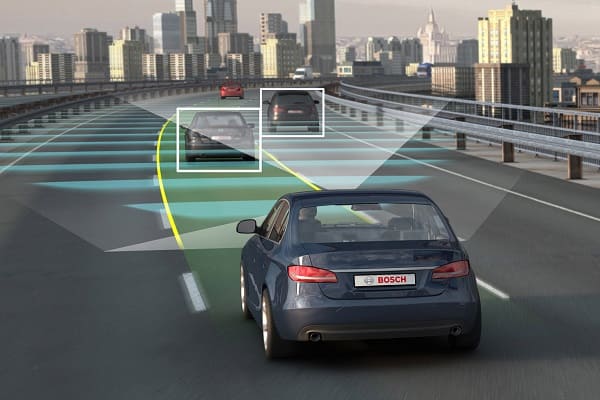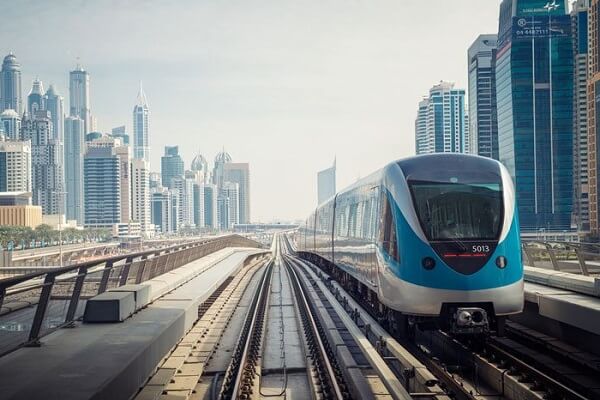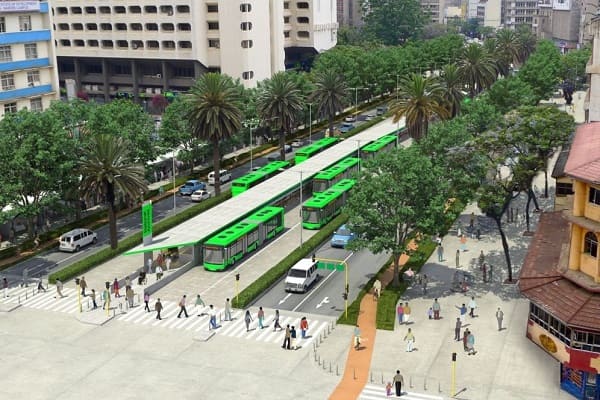 Delhi unveils ambitious Urban Mobility Vision: Luxury Metro Coaches, New Tunnels and Pod Taxi
Delhi unveils ambitious Urban Mobility Vision: Luxury Metro Coaches, New Tunnels and Pod Taxi Qatar approves Saudi Rail Link Agreement, Accelerating Gulf Railway Vision 2030
Qatar approves Saudi Rail Link Agreement, Accelerating Gulf Railway Vision 2030 UP Govt plans to introduce Water Metro services in Ayodhya, Varanasi & Prayagraj
UP Govt plans to introduce Water Metro services in Ayodhya, Varanasi & Prayagraj India’s First Urban Ropeway begins Trial Run in Varanasi, Set to carry 1 Lakh passengers daily
India’s First Urban Ropeway begins Trial Run in Varanasi, Set to carry 1 Lakh passengers daily India and Bhutan to Build First-Ever Rail Link: ₹4,033 Cr Project to Boost Regional Connectivity
India and Bhutan to Build First-Ever Rail Link: ₹4,033 Cr Project to Boost Regional Connectivity Patna to launch Eco-Friendly Water Metro; Trial Run soon between Digha and Kangan Ghats
Patna to launch Eco-Friendly Water Metro; Trial Run soon between Digha and Kangan Ghats Air India Group set to launch Flights Operations from Navi Mumbai International Airport
Air India Group set to launch Flights Operations from Navi Mumbai International Airport Chennai to launch 25-Year Mobility Plan with Unified QR Ticketing and One-App Transit System
Chennai to launch 25-Year Mobility Plan with Unified QR Ticketing and One-App Transit System Kochi Metro bags ₹4.4 crore contract to prepare DPR for Mumbai Water Metro Proejct
Kochi Metro bags ₹4.4 crore contract to prepare DPR for Mumbai Water Metro Proejct Navi Mumbai International Airport set for September launch; IndiGo and Akasa Air to lead Operations
Navi Mumbai International Airport set for September launch; IndiGo and Akasa Air to lead Operations
9 Innovative Technologies Enhancing Public Transport Efficiency

In the early 1800s, France introduced the omnibus, a horse-drawn carriage capable of ferrying up to 40 passengers across urban areas. Little did they know that this would be the world’s first example of public transport — and serve as inspiration for more efficient innovations, such as cable cars and public buses.
Two hundred years later, the world is standing on a similar precipice. With technologies such as IoT and blockchain disrupting public transport as we know it, the near future seems as unpredictable as it was back in 1826 France.
Let’s decode the latest trends and outline nine innovative technologies that are enhancing public transport efficiency.
1. IoT Sensors and Telematics
Telematics leverages various IoT-enabled sensors to offer transit authorities real-time insight into operations.
The data a telematics solution collects helps drivers identify optimal routes, maintain fuel levels, and stay on schedule. Travelers can use the data to determine how crowded a bus is and plan trips accordingly, reducing the strain on public transport infrastructure. Meanwhile, in Sweden, experts are studying how these sensors can be used to monitor air pollution in real-time to help reduce emissions.
Transit authorities also benefit. For instance, certain IoT sensors, such as Electronic Logging Devices (ELDs) — which are mandated by the Department of Transportation — help manage drivers’ working hours. Crucially, ELDs ensure compliance with the DOT 70 hour rule, which states that drivers must not exceed 70 hours on-duty over an 8-day period. This prevents fatigue and improves efficiency.
2. AI-Enabled Predictive Analytics/Maintenance
Artificial Intelligence technologies are also increasingly being employed to enable predictive analytics and maintenance — both crucial for efficiency.
The former, for instance, leverages data and analyzes it with advanced algorithms to prevent potential disruptions and forecast travel patterns.
At the same time, AI systems can be used to track data related to temperature or energy consumption to enable proactive maintenance of public transport vehicles. This helps avoid breakdowns and minimizes disruptions, ensuring efficient public transport.
3. Digital Twins
A digital twin is a virtual representation of a physical object that can be used to simulate real-life situations and test possible outcomes. When applied to public transport, digital twins can help authorities make better, more data-driven decisions.
For instance, a digital twin of an urban area — with its population, roads, and traffic patterns — can help transit authorities create a more robust infrastructure. Both Singapore and Shanghai are experimenting with the technology, using digital twins of their transport systems to ease bottlenecks and monitor emergencies.
Automotive digital twins can also ensure that vehicles run more efficiently. A replica can be created of a vehicle’s electrical components — 3-D automotive wiring diagrams, for example — to prevent short circuits and blown fuses or suggest better designs.
4. Blockchain
Until a few years ago, blockchain was primarily associated with cryptocurrency. But that has since changed. Today, distributed ledger technology (DLT) is disrupting almost every industry, finding takers even in public transport.
The technology stands to improve efficiency on a few levels. On the government level, it enables traffic departments to monitor congestion, road conditions, and issue licenses. At the same time, DLT allows passengers and drivers to purchase and sell travel tickets.
The Maltese government, for example, has partnered with blockchain solution Omnitude to enhance its public transportation system by creating an advanced transport and logistics platform.
5. Mobility-as-a-Service
MaaS apps are an on-demand service that integrates various modes of public transport — trams, buses, subways, etc — into one platform. This enables travelers to plan and pay for a trip on a single digital app rather than buy tickets for each mode of transport. MaaS solutions also leverage technology to identify ideal routes, cutting down travel times and increasing the efficiency of services.
Countries like Finland, Japan, China, and the UK — among others — have piloted early versions of MaaS solutions, each with its unique features. In Beijing, for example, travelers are rewarded when they select greener modes of transport.
6. Electric Vehicles
In 2024, EVs are hardly new technology, with car manufacturers releasing newer models by the day. Simultaneously, e-bus adoption has been on the rise, with the number of transit Battery Electric Buses (BEBs) growing by 112% between 2018 and 2021 in the U.S.
E-buses have been hailed as a more efficient alternative than their diesel counterparts, as they require no fuel and have lower maintenance costs.
So, as cities ramp up their EV infrastructure and find answers to crucial considerations — such as, what drains an EV battery? — it won’t be long before we see the e-bus revolution do its part to enhance the efficiency of public transport.
7. Autonomous Vehicles
In 2023, Scotland piloted the world’s first autonomous bus service on a route between Fife and Edinburgh. The bus operates at level 4 of autonomy, ferrying up to 10,000 passengers a week on the 14-mile route, with a maximum speed of 50 mph. This means that while a driver is onboard, they don’t drive the vehicle—they simply monitor systems.
The launch of such a service is a clear signal that it won’t be long before driverless vehicles take over public transport — not just buses but also trams, taxis, and subways. These vehicles leverage AI technologies to find the best routes while improving the safety of passengers and the efficiency of public transportation systems.
8. Intelligent Transport Systems
Intelligent transport systems (ITS) refer to a collection of IoT-enabled technologies that make streets and transit systems smarter, safer, and more efficient.
ITS systems link vehicles to other vehicles, as well as to infrastructure — such as traffic signals or road markings — to monitor traffic in real time, adjust signal timings, and suggest dynamic routes. This connectivity helps reduce travel times and improve fuel efficiency. ITS technologies can also prevent collisions, making public transport safer.
New York is among the cities leading the way in ITS technologies, installing power cameras and sensors at over 10,000 traffic intersections in 2019.
9. Bus Rapid Transit
While the term rapid transit is generally associated with rail services — or, in recent years, the contentious Hyperloop project — Bus Rapid Transit has emerged as one of the fastest-growing modes of transport in the U.S.
While not a new technology in itself, BRT projects are now adopting several ITS innovations to enable buses to move quickly through traffic signals and gain priority at intersections. On-board GPS trackers help ensure that buses stick to schedules, while smart ticketing systems reduce the time spent queuing.
BRT systems already operate in several big cities across the U.S. (and the world) but are now rising in popularity even in mid-sized metropolitan areas, leveraging the latest technologies to make public transport more efficient — and attractive to passengers.
Looking Out for Public Transport’s Future
The United Nations estimates that by 2050, 68% of the world’s population will live in urban areas. Given this massive shift — as well as rising climate goals — it’s clear that improving the efficiency of public transport will no longer be an option but a necessity. As urbanization increases congestion, pollution, and energy consumption, investing in sustainable and efficient public transportation systems becomes imperative to mitigate these challenges and ensure the well-being of urban populations.
Graham Perry is a writer at Business Tech Innovations specializing in logistics supply chain optimization. With expertise in fleet management and transportation technology, his articles empower businesses to navigate the dynamic world of logistics with peace of mind.






